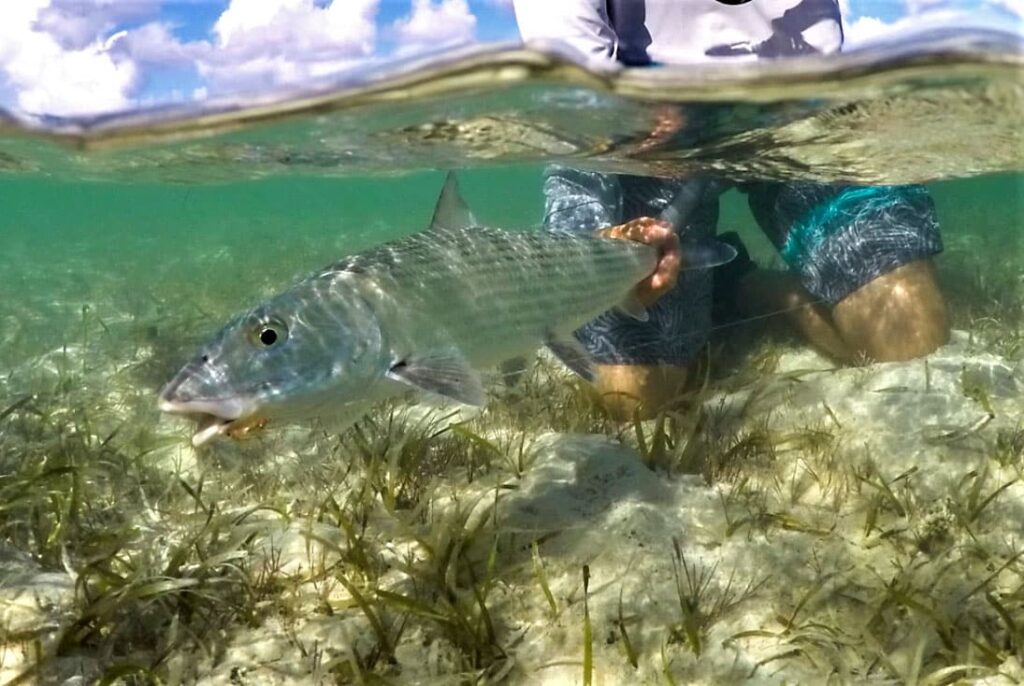Florida Keys bonefish are thrilling targets in the fall, whether you pursue them with a fly rod or set up to catch them using fresh, live shrimp. — Steve Waters
Capt. Richard Stanczyk remains active managing Bud N’ Mary’s Marina in Islamorada, but this season, as the Florida Keys weather cools, he sets aside afternoons to take family and friends bonefishing.
A combination of factors has significantly enhanced the water quality in Florida Bay around Islamorada, leading to successful flats fishing. “When I used to take clients bonefishing, I’d promise them ‘a beautiful sunset.’ Now, I can almost guarantee them a bonefish,” Stanczyk mentions. “The flats have improved; there’s no doubt. The water quality this year has been the best I’ve seen in many years.”
Capt. Richard Stanczyk typically prefers waiting for the bonefish to approach him while staked out on flats where the fish roam. — Steve Waters
Optimal Flats and Conditions for Bonefish
While anglers can catch bonefish in summer heat, Stanczyk considers fall his favorite season for pursuing these elusive fish. “Temperature is crucial, and we often just transition from extreme heat,” he elaborates. “You need to fish very early in the morning due to the cooling that occurs overnight, with another good window in the late afternoon.”
However, catching bonefish becomes challenging when water temperatures fall below 72 degrees. As a November cold front hits, Stanczyk notes that bonefish head towards deeper, warmer water offshore of Islamorada.
With Florida Bay’s water temps comfortable for bonefish, Stanczyk explores various flats. His extensive experience (over 40 years) informs him about where the fish might be, dependent on tides and wind.
He seeks flats combining healthy, green grass with sand and gravel and avoids those with brown, matted algae or “rusty-looking dust,” which signals poor water flow.
“Sometimes, you have large, open flats receiving ample sunlight. Fish shy away from these areas, preferring the edges, especially in calm conditions. Wind helps somewhat,” he explains.
Stanczyk also discovers fish near what’s known as a strip bank, where a narrow bank rises and creates churning water over the obstruction. Fish tend to gather there, eager to feed.
Using Live Shrimp to Catch Bonefish
When Stanczyk first arrived in the Keys during the 1970s, he solely fly-fished for bonefish, scanning shallow flats for tailing fish or swimming fish shadows.
Over the last two decades, rising water levels have affected visibility, with flats that previously had 6 inches now submerged under 2 to 3 feet of water, complicating spotting fish.
While some attentive backcountry guides still pole across the flats, Stanczyk, in this stage of his career, prefers dead-boating or staking out, allowing the fish to find him rather than chasing them.
He carefully positions his skiff on a flat where he aims to intercept bonefish, using prevailing wind and current to his advantage. A push pole secures his boat to the sandy bottom.
Once anchored, he prepares two to four spinning outfits baited with live shrimp, casting them into chosen spots across the flat.
Stanczyk visualizes the flat like a road map with one entry and exit. He believes that in the correct conditions, bonefish will traverse this route and discover the shrimp.
Preparing Light Tackle for Bonefish
For dead-boating, Stanczyk emphasizes placing bait at the edge of grass and sand, enhancing visibility and scent for the fish to find the shrimp.
He advocates for light spinning gear with 12-pound monofilament line: “Over-tackling bonefish diminishes the excitement, challenge, and enjoyment,” he advises.
A sinker weighing between 1/8 and 1/2 ounce, depending on current strength, is positioned above a swivel tied to 12–18 inches of 12 to 20-pound monofilament leader, concluding with a 2/0 Gamakatsu Offset Worm EWG hook, as smaller hooks may be swallowed.
Stanczyk removes the shrimp’s tail and slides it onto the hook tail-first, ensuring complete hook concealment. After casting, he secures the spinning rods in holders, vigilantly watching the tips for any movement.
“What you should monitor is the bonefish attempting to take the shrimp,” Stanczyk notes. “When it noses down onto your bait, that’s your cue. Lift the rod, but don’t alarm him.”
When a fish swallows the shrimp, he emphasizes reeling without jerking; “If he’s not there, halt reeling. He’ll come back for it,” he clarifies. “If he’s taken it, he’ll bolt, so allow him his initial run.”
After a couple of runs, the bonefish tires, allowing for the opportunity to photograph the trophy once it comes alongside the boat. After successfully letting the first fish approach, you can try scouting and hunting. Look for tails and shadows, but remember, if unsuccessful, staked out fishing always remains an option.

